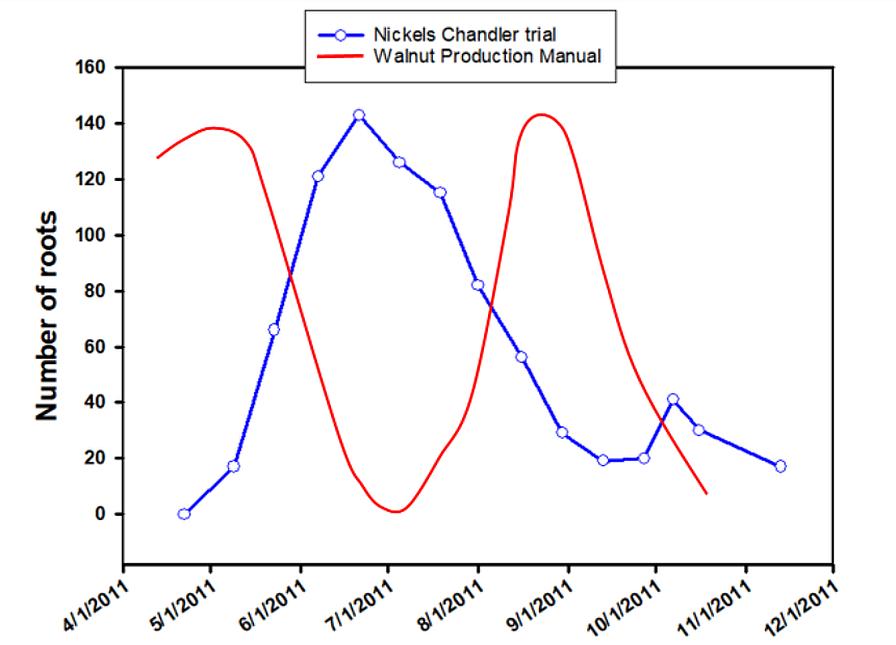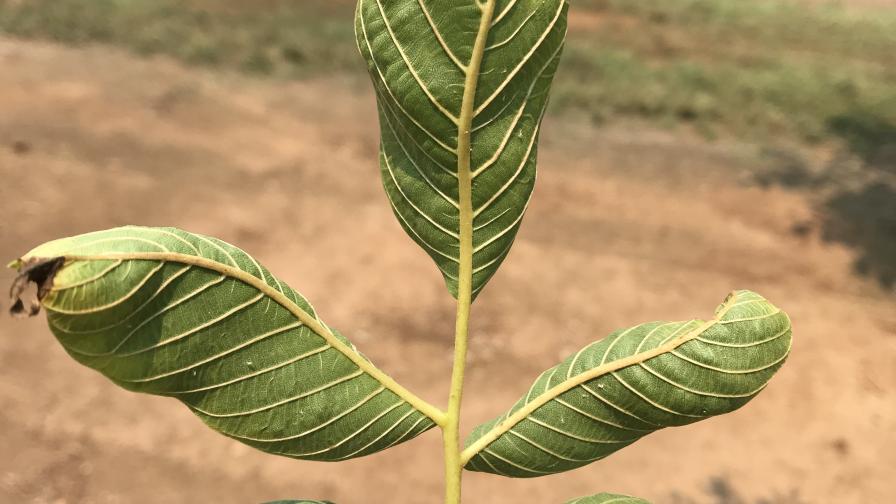Keep Roots in Mind for Effective Walnut Irrigation
Roots are responsible for water and nutrient uptake. Roots do not function well when exposed to too much water and will stop growing and eventually die in saturated soil conditions.
A better understanding of root biology can improve your irrigation management.
WHEN DO ROOTS GROW?
There is a false understanding in walnut production that there is a flush of root growth in both spring and fall. In fact, there’s even a figure in the 1996 University of California “Walnut Production Manual” that shows these two flushes of root growth where the fall peak is larger than the spring peak.
Research of the ‘Chandler’ variety by Bruce Lampinen and his lab at University California, Davis instead shows that, in most years, there was a single major root flush that peaked in late June. These new fine roots are responsible for most nutrient and substantial water uptake. There is a constant turnover in fine root production during this period, with new roots being produced, and older roots dying, or (after about two weeks) suberizing and becoming part of the water and nutrient transport system instead of an active site of uptake. Occasionally there was a small flush of root growth in late summer/early fall, but this amount was substantially lower than the spring flush.

The number of roots over time in ‘Chandler’ on Paradox Seedling (2011 Nickels Soil Lab in Arbuckle, CA) versus what is shown in the 1996 “Walnut Production Manual.”
Source: Bruce Lampinen, UC, Davis.
ROOT LOCATION
The fine roots are concentrated in the top 2 feet of soil. However, declines in soil moisture from spring to fall indicate substantial water uptake from roots located in deeper soil layers where moisture is still available when soils allow for deep root growth. If the soil is allowed to dry more near the surface, or there are subsurface sources of water such as water tables, these deep roots can contribute substantially to water uptake.
During the single spring root flush, extended saturated/stagnant soil moisture conditions can cause tremendous long-term damage to root and tree health. New root tissue requires lots of oxygen because roots respire by breaking down carbohydrates for energy, just like humans.
Flooding of soils strongly reduces the amount of oxygen available to the roots. When roots are deprived of oxygen during saturated soil conditions, new root production is the first process to stop. If low oxygen conditions continue, root death, and eventually tree death, can ensue.

Distorted leaf margins and leaf tip burn are some of the leaf symptoms associated with early season over-watering in walnut.
Photo by Luke Milliron
Irrigation Management Implications
The negative root health impacts of saturated conditions mean long irrigation run times that lead to standing water should be avoided. The negative impacts of sustained wet conditions have been well documented, including the development of leaf damage symptoms: sacvalleyorchards.com/ walnuts/irrigation-walnuts/leaf-symptoms-overwatered-walnuts. In such cases it is wasteful to apply more nutrients, the simpler solution is to reduce irrigation and allow root growth to occur.
Conversely, drier, better aerated conditions during the root flush may promote growth from deeper roots with greater water uptake by deep roots. Research has shown that using the pressure chamber to delay the first irrigation until stem water potential readings fall two to three bars drier than the fully watered baseline (typically in May or June), lead to trees with a healthier appearance that are less water stressed at harvest.
This beneficial result of delayed irrigation may be due to greater root development and exploration during the May-June root flush, which leads to a greater volume of soil moisture accessible at harvest. Although deep roots can access stored soil moisture and play a critical role early in the season, if you run long irrigation sets in an attempt to replenish deep soil moisture during the irrigation season, the most important roots in the top 2 feet, and tree health overall, will likely suffer from poor aeration. You can read more about the study at: sacvalleyorchards.com/walnuts/irrigation-walnuts/spring-start.
Waiting to irrigate until stem water potential readings fall two to three bars drier than the fully watered baseline is an appropriate irrigation trigger not only for the start of the season but also season long. This integrated measure of tree water status is especially valuable considering we never know the location of all roots contributing to water uptake. A step-by-step guide on using the pressure chamber is available at: sacvalleyorchards.com/manuals.
Author’s note: A version of this article first appeared in the spring 2020 issue of the Sacramento Valley UCCE Walnut Newsletter: sacvalleyorchards.com/walnuts/irrigation-walnuts/irrigation-with-roots-in-mind. Co-authors: Astrid Volder (UC Davis), Allan Fulton (UCCE), Phoebe Gordon (UCCE), and Bruce Lampinen (UC Davis). The article was based on a Growing the Valley podcast: growingthevalleypodcast.com /podcastfeed/roots.










